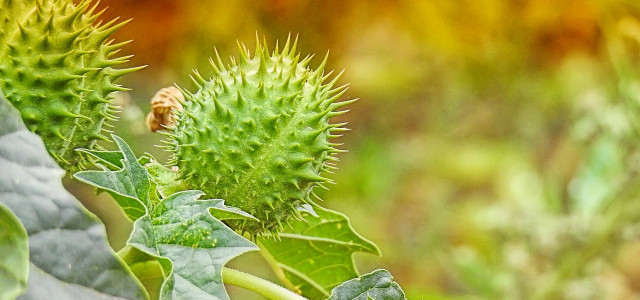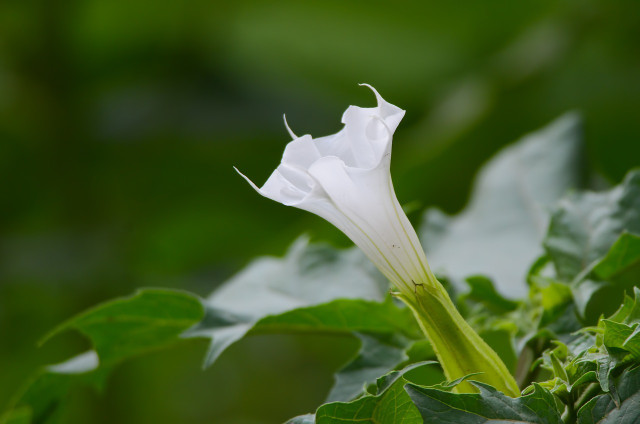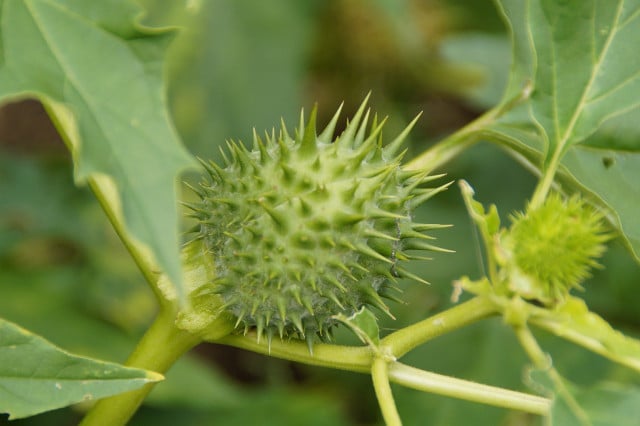
The common thornapple is beautiful to look at, but is extremely poisonous if eaten. Here you will find an overview of the most important information on its appearance, occurrence and effects.
Originally from North America, you can now also find the common thornapple in Germany. The nightshade plant likes to grow on rubble, roadsides and garbage dumps – but also in domestic gardens and vegetable patches.
This can cause problems because all parts of the common thornapple are poisonous to humans and animals, especially its seeds and roots. Therefore, it is often advisable to remove the plant, especially in households with children and pets.
Warning: If you have ingested any part of the thornapple plant – no matter in what quantity or which part of the plant – seek medical help.
Common thornapple: origin and distribution
The common thornapple (also known as Datura stramonium, thunderball or devil’s apple) is a shrub plant from the nightshade family. It originally comes from Mexico, but is now widespread throughout the world in warm and sunny climates. Even though the thornapple grows very quickly, it is only found as an annual plant in Germany due to the cold winters.
But how does the thornapple get into your garden?
In nature, thorn apple spreads through the bursting of the seed capsules, which are then distributed by animals or wind within a radius of one to three meters around the mother plant. The closed, dry seed capsules can also get caught in the fur of wild animals and thus be distributed over longer distances.
Today, however, agricultural activities also play a major role in ecology. For example, thorn apple seeds are carried over long distances by harvesting machines and can end up on field paths, from where the plants can spread further.
Characteristics: How to recognize the common thornapple

(Photo: CC0 / Pixabay / binghamdi)
Before it flowers and produces seeds (June to September), the common thornapple is difficult to recognize as such, as it resembles many other European bushes with its rather bare shoots and dark green, slightly pointed leaves.
However, you can easily identify it when the flowers form:
- The flowers of the thorn apple are funnel-shaped and can be white or purple, or a mixture of both colors.
- They have a strong sweet, almost perfume-like scent.
- The flowers always grow between two branches of the bush, in its “armpits”, so to speak, and after just one night they wilt and fall off.
- The flowers of the thorn apple are always upright and point upwards. This is good to know, as this is how they differ from the flowers of the angel’s trumpet, with which the thorn apple is sometimes confused. The flowers of the angel’s trumpet always hang downwards.
After flowering, the thorn apple forms its characteristic prickly seed pods (July to October), also called ovaries, which you can recognize by the following characteristics:
- Visually, the seed pods are reminiscent of the fruit pods of chestnuts: they are light green, prickly, egg-shaped and grow to about three to eight centimeters in size.
- In autumn and winter the pods ripen and dry out until they finally open at their tip and release several hundred deep brown to black, kidney-shaped seeds.
The bush can grow to be over a meter tall and its roots reach up to one and a half meters into the ground.
What makes the thorn apple so poisonous?

(Photo: CC0 / Pixabay / PublicDomainPictures)
The common thornapple is considered one of the most poisonous plants in our gardens, as every part of the plant contains toxins that can cause serious illness if consumed. The roots and seeds are particularly poisonous.
Caution! Even though the common thornapple causes discomfort, especially when eaten, the AGES (Austrian Agency for Health and Food Safety) warns against touching the plant with bare hands. After eating any part of the plant – even in small quantities – you should go to a clinic immediately, because according to the Bonn Poison Control Center, the toxins contained in the thornapple can be fatal depending on the dosage.
This is because thorn apple contains high amounts of so-called tropane alkaloids, which affect the nervous system because they inhibit the effect of the body’s own messenger substance acetylcholine. The latter’s job is to transmit nerve impulses. Poisoning by thorn apple can lead to symptoms such as hallucinations, nausea, dizziness and breathing problems.
The effect of thorn apple is not necessarily bad in itself: Like many other native poisonous plants, thorn apple is used as a medicinal plant in small doses, for example as a remedy for asthma and coughs, and is therefore still found in many pharmacy gardens today. However, pharmacies strongly advise against self-medication with thorn apple due to the high poison content.
How to remove thorn apple safely: A guide

(Photo: CC0 / Pixabay / Efraimstochter)
There are two situations in particular where it is advisable to remove the thornapple from your garden:
- If you have small children or pets who might eat the flowers or seeds of the plant.
- If the thornapple plants are growing in your vegetable patch or anywhere else where they could accidentally come into contact with your crops (for example, when harvesting potatoes, the roots of the thornapple could end up in your harvest basket).
Instructions for the safe removal of the thornapple plant:
- The basic rule is: ideally, remove the plant before the fruit capsules form, or before the capsules dry out and burst. This way you can ensure that the thorn apple cannot spread any further and that you do not have thorn apple plants in your natural garden again the following year.
- Wear gloves when removing the plant.
- You can carefully pull the plant out by hand or dig it out with a spade. Try to dig out all the roots if possible, especially if the common thornapple is growing in a vegetable patch.
- Place the dug-up plant in a garbage bag or organic waste bag and dispose of it in your residual waste, together with your gloves.
- Then wash your hands thoroughly!
Read more on Utopia:
- Poisonous plants for cats, dogs and rodents: These can harm your pets
- Recognize wild garlic – and don’t confuse it with poisonous lily of the valley: Here’s how
- Native medicinal plants: The most powerful plants and their effects
** marked with ** or orange underlined Links to sources are partly affiliate links: If you buy here, you are actively supporting Techzle\.com, because we then receive a small part of the sales proceeds. .